I have a small urban garden. Each spring, lots of little bee visitors begin arriving. The first is always a big queen Buff-tailed bumblebee, usually popping in to feed on our Crocuses. After that a progression of different wild bees appear through the spring and summer. By autumn, it’s usually just the Common Carder Bumblebee left before it too goes into hibernation for the winter.
Over the last few years, I’ve been making a note of the different wild bee species that use our small garden. At the minute the tally is 18! Honeybees also pop in occasionally from a nearby hive. For a small urban garden, 18 out of a total of 100 Irish wild bee species isn’t bad. Especially when you consider that one third of our wild bees are threatened with extinction from the island of Ireland.
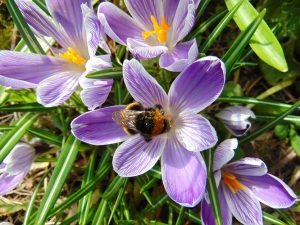
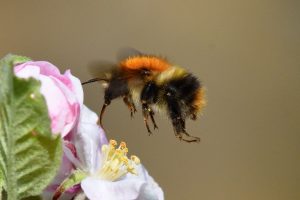
Hover over the photos to see the details
Old friends
Across the year, it’s become like a series of old friends visiting. I freely admit that I have a huge soft spot for all the wild bees that use our garden as a pitstop during their busy lives. However, I’ll just mention some of my favorites. I love to see the arrival of the Grey Mining bee (Andrena cineraria), typically feeding on Dandelions. For me, it’s a sure sign that spring is definitely here. A few weeks later, I often see Marsham’s Nomad Bee (Nomada marshamella), usually hanging around our Currant bushes. It looks innocent, but I know different! It’s a cuckoo bee species. This means it steals the nest of another solitary bee instead of creating its own. The female Nomada marshamella enters the nest of one of the mining bee species and lays an egg near the pollen food supply gathered by the owner. When the cuckoo bee’s egg hatches into a larva, it uses the food supply intended for the owner’s young!
When our summer Raspberries flower, their most common visitor is the Early bumblebee (Bombus pratorum). This is Ireland’s smallest bumblebee, and the little workers spend weeks busily collecting raspberry pollen. I always wish I could say thank you, as I know what an incredible crop of raspberries I’ll get a few months later, thanks to their hard work! When the apple tree is in flower, I’ll usually see the Early Mining Bee (Andrena haemorrhoa) busy pollinating. This little solitary bee has a tiny red tail. The other mining bee that I commonly spot is Gwynne’s Mining Bee (Andrena bicolor), it has bright orange hairs on the back legs. For those of us who experienced the 1980’s, they look like a pair of orange leg warmers.
The Orange-legged Furrow Bee (Halictus rubicundus) is also a common visitor. This one always reminds me of when I was teaching a student about solitary bees and announced that you never have to worry about stings. Only to have him lean on a nearby wall with his hand – right on top of a Halictus rubicundus female. She did rightfully give him a tiny little sting!
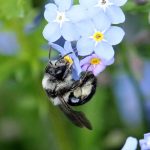
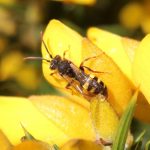
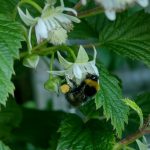
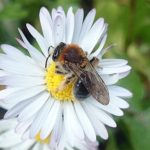
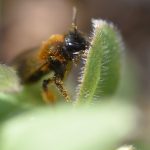
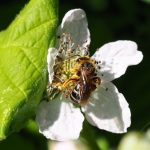
The ones I wish I saw more of are the Leaf Cutter Bees. I know where they nest – in holes in a concrete pillar not far from the house. It visits us to feed, though we’ve more likely to see the circular pieces cut out of our rose bush than to see the actual bee. The female cuts out circular pieces of leaf or petal and flies them back to line the cells in her nest. Watching them at work is nothing short of a joy. These are the solitary bees most likely to use a bee box. You’ll know your box is occupied if you see a little piece of leaf or petal closing off the entrance to the cavities.
The Red Mason bee (Osmia bicornis) arrives every year. It usually feeds on the areas of the grass where we ‘Don’t mow, let it grow’. Another one that hangs around our tiny meadow is the Wool Carder Bee (Anthidium manicatum). This one is a large bee (8-12mm), with distinctive yellow markings on the sides of the abdomen, head and legs. Unlike other male solitary bees, this one will vigorously defend clumps of favoured flowers (Bird’s-foot-trefoil in our case) and will intercept and chase away any other insect that enters its territory. However, he does make an exception for females, who he allows to visit the flowers, and it’s here that mating takes place. Female Wool carder bees need hairy plants like Lamb’s Ear or Woundwort as they collect the hairs to bring back to line their nests.
The last one I’ll mention is the Red-tailed Bumblebee (Bombus lapidarius). The females are jet black with a red tail. The males look similar, but also have a yellow band and yellow hairs on their face. In late summer, queen bumblebees lay unfertilised eggs, and these become males. When they reach adulthood, the males are kicked out of the nest and have to fend for themselves. In late summer, when I come out to the garden in the morning, I’ll find lots of dozy Red-tailed bumblebee males, hanging onto our lavender spikes, where they’ve spent the night. They’re only interested in chasing girls and drinking (nectar), so I don’t feel too sorry for them…
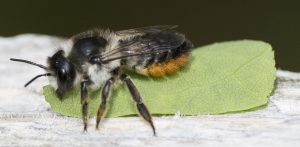
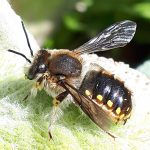
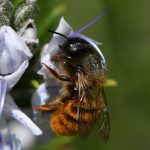
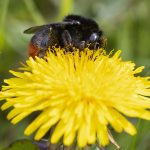
Making your garden pollinator-friendly
I have pledged my garden for pollinators. Most of the grass we cut once a month, instead of every few weeks. Two small strips of meadow we allow to grow all summer from March through until early September. I would never plant a wildflower seed mix – little flowers have popped up themselves – ones that are meant to be there. By managing like this, and removing the cuttings, it improves year on year on its own. It’s this that supports most of our insect visitors and that gives me most joy in our garden. I love seeing what little plants will naturally appear amongst the grass. Some years it’s a profusion of Speedwells, other years we get lots of Dog Daisies, and sometimes a big purple carpet of Self-heal. Nature does its own thing in ways we’ll probably never fully understand. When you allow it into your garden, it brings never-ending interest and enjoyment.
I do also love gardening and horticultural plants. On that side of things, I like to choose only those that are rich in pollen and nectar, and I try to make sure that I always have something flowering from February through to late October.
In spring, that’s bulbs like Crocus and Grape Hyacinth, as well as early flowering shrubs (Broom, Berberis) and perennials (Hellebores, Lungwort). In summer and autumn, I make sure I have a range of perennials so that something is always providing food (e.g., Wallflower, Verbena, Catmint, Lavender, Aster). I love to plant herbs (Thyme, Oregano, Chives), which we use ourselves as well as providing food for bees. We also have a Laburum tree, whose yellow hanging flowers literally hum for weeks with bumblebees in late May. When I buy summer bedding plants, I only ever go for pollinator-friendly options. Two great ones are Bidens and Bacopa. Last year, the Bidens I planted had lovely little yellow flowers across the entire season and was still flowering on Christmas Day! I also love planting seeds in pots or growbags each spring, and chose hardy annuals that are good for pollinators – usually Sunflower, Cosmos and Cornflower. Come autumn, I make sure to save some of the seed to use the following year and leave the rest for birds.
I don’t grow large volumes of fruit and vegetables, but I do like to grow a whole range of different types that need to be pollinated (Currants, Raspberry, Strawberry, Apple, Plum, Blueberry, Tomato, Courgette, Peas, Beans, Pumpkin). They all provide food for pollinators in the garden. In return, I get well-pollinated and healthy crops!
You can find ideas for what to plant throughout the year in our guide for pollinator-friendly plants and herbs.
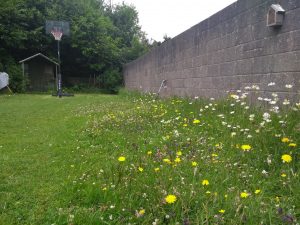
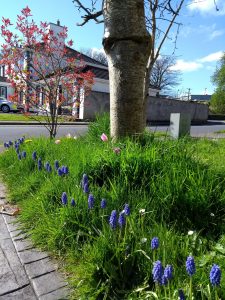
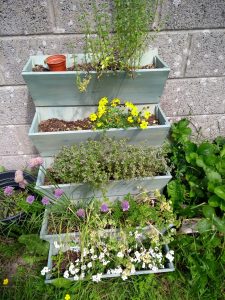
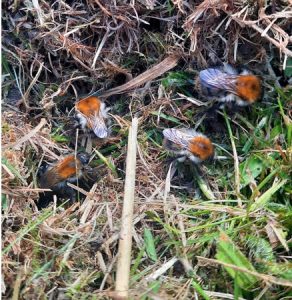 Do wild bees nest in gardens?
Do wild bees nest in gardens?
Small gardens will typically be used more for feeding than nesting. I have a solitary bee nest box in the garden, but it hasn’t been used. I keep it in the hope that the leafcutters might realise it’s there and set up home so I can watch them coming and going with their pieces of leaf or petal. I also leave some small areas of bare soil, and some years the Grey Mining Bee will burrow in to make their tiny nests. Most years, we have a Common Carder bumblebee nest along the edge of our tiny front lawn. They come and go continuously, only noticeable when we cut the grass (once a month!). When that happens, they’ll buzz around the entrance indignantly for 10 minutes before happily settling back down again. They’re often found in slightly mossy lawns. They make their nest on the surface of the ground, hidden within moss and grass which they’ve used to construct their nest.
Find out more in our How-to-guide for creating wild pollinator nesting habitats.
Do gardens just help common species?
For many of us the answer might be yes. But common species are incredibly important. Over three quarters of the wild plants in Ireland also benefit from insect pollination. Pollinators are needed everywhere to support our wild plants, as well as if we want to grow fruits and vegetables. I also manage the All-Ireland Bumblebee Monitoring Scheme within the National Biodiversity Data Centre. Unfortunately, it is showing us that many of our common species are struggling. Gardens, however small, can be lifesavers. For others, lucky enough to live in areas close to populations of rarer species, the potential for your garden to help is enormous. In the Mullet peninsula of County Mayo, that might be the endangered Great Yellow Bumblebee. Within the Burren, it might be the Shrill Carder Bee, or for those communities e.g., Skerries, Tramore, lucky enough to still have the declining Large Carder bee, your ability to help is significant.
Recent studies have shown that gardens can have remarkably high pollinator diversity. As it’s unlikely for two gardens to have the same species of plants, in combination they provide a range of pollen and nectar sources and can be incredibly important for our insects. Some people are happy to have a wilder garden with unmown areas, while others prefer to focus on pollen and nectar-rich garden plants. It’s important to respect what works best for each person and know that together everyone is helping.
Know that you are making a positive difference
If you make your garden pollinator friendly, chances are you are supporting a whole range of different wild bee species, never mind all the other fascinating insects that will also use the habitat you have created. If we all created little pit stops for wild bees and other insects in our gardens, the collective impact would be huge.
To mark World Bee Day 2022, consider pledging your garden for pollinators and help protect our insects for future generations.
Report what you see
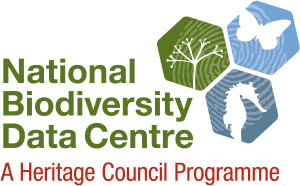 I know that I’m very fortunate to be able to recognise all our garden bee visitors. Within the National Biodiversity Data Centre, we have lots of free resources to help you get started in learning about Ireland’s wild bee species. When you’re confident in what you are spotting, please submit your sighting to us via our smart phone recording app, or online at: https://records.biodiversityireland.ie
I know that I’m very fortunate to be able to recognise all our garden bee visitors. Within the National Biodiversity Data Centre, we have lots of free resources to help you get started in learning about Ireland’s wild bee species. When you’re confident in what you are spotting, please submit your sighting to us via our smart phone recording app, or online at: https://records.biodiversityireland.ie
Learn to identify common bumblebee: free online course: https://biodiversityireland.ie/identifying-irish-bumblebees/lesson.html
Buy our bumblebee identification swatch: https://biodiversityireland.ie/shop/
Solitary bees for beginners: https://pollinators.ie/record-pollinators/solitary-bees-for-beginners/
Become a citizen scientist and help monitor the insects in your garden
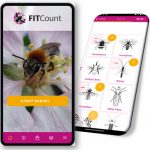 You can also help monitor the insects in your garden by taking part in one of our monitoring schemes.
You can also help monitor the insects in your garden by taking part in one of our monitoring schemes.
Flower-Insect Timed Count: download the FIT Count app, watch a patch of flowers for 10 minutes and count how many insects visit. Do as many or few FIT Counts as you like https://biodiversityireland.ie/surveys/fit-counts/
Garden Butterfly Monitoring Scheme: make regular 15-minute counts of the butterflies seen in the garden, on at least a weekly basis from 1st April to 30th September each year. https://biodiversityireland.ie/surveys/garden-butterfly-monitoring-scheme/
These are the 18 species of wild bees that have been using my garden over the last few years
- Garden Bumblebee – Bombus hortorum
- Red-tailed Bumblebee – Bombus lapidarius
- White-tailed Bumblebee – Bombus lucorum
- Common Carder Bee – Bombus pascuorum
- Early Bumblebee – Bombus pratorum
- Buff-tailed Bumblebee – Bombus terrestris
- Gwynne’s Mining Bee – Andrena bicolor
- Grey/Ashy Mining bee – Andrena cineraria
- Early Mining Bee – Andrena haemorrhoa
- Buffish Mining Bee – Andrena nigroaenea
- Chocolate Mining Bee – Andrena scotica
- Early Nomad Bee – Nomada leucophthalma
- Marsham’s Nomad Bee – Nomada marshamella
- Orange-legged Furrow Bee – Halictus rubicundus
- Common Furrow Bee – Lasioglossum calceatum
- Brown-footed Leafcutter Bee – Megachile versicolor
- Red Mason Bee – Osmia bicornis
- Wool Carder Bee – Anthidium manicatum
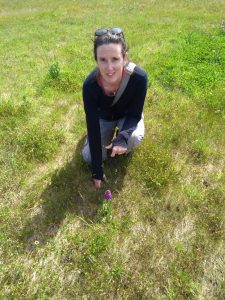
Dr Úna FitzPatrick is a Senior Ecologist in the National Biodiversity Data Centre. She is co-founder and project manager of the All-Ireland Pollinator Plan.
